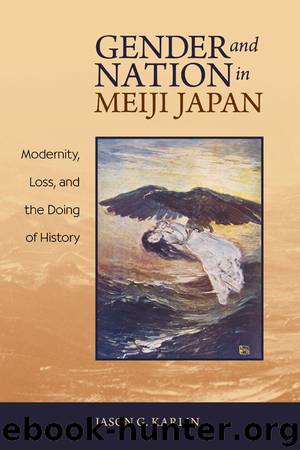Gender and Nation in Meiji Japan: Modernity, Loss, and the Doing of History by Jason G. Karlin

Author:Jason G. Karlin [Karlin, Jason G.]
Language: eng
Format: epub
Tags: History, Historiography, Asia, Japan, Social Science, Gender Studies
ISBN: 9780824838263
Google: vfS3ngEACAAJ
Publisher: University of Hawaiʻi Press
Published: 2014-04-14T15:00:00+00:00
FIGURE 3.5. “Genroku geisha,” by Yamamoto Matsutani. SOURCE: Fūzoku gahō, no. 322 (Aug. 10, 1905).
Another source of popular fascination with the Genroku era was the legend of the Forty-Seven Rōnin Incident of 1702 (Genroku 15) immortalized in the story of Chūshingura. Fukuchi Gen'ichirō contributed to this revival by penning the story to the popular kabuki play Jitsuroku chūshingura, which debuted in 1890. The narrative of the righteous resistance of defiance in seeking vengeance appealed to a wide audience that increasingly saw the sacrifice and motives of the forty-seven samurai as an expression of a lost Japanese spirit. Fukuchi himself was critical of the Genroku era, and, counter to the popular perception promoted by Chūshingura that associated Genroku with bushido values, he argued that the Genroku era witnessed the decline of bushido.109 For Fukuchi, the vengeance of the loyal retainers of the Akō clan was not a product of Genroku-period bushido but merely a “holdover” (ibutsu) from the past.110 The renewed popularity of the Chūshingura story during the Meiji period, with its extolling of the virtues of righteous resistance and loyalism, heightened awareness of the Genroku era such that the revival of Genroku was not limited solely to style and form, but also included the desire to return to the perceived cultural and ethical values of the past.
On July 23, 1905, the first meeting of the Genroku Study Group (Genroku Kenkyūkai), organized by Togawa Zanka, was held in Tokyo and attended by more than fifty artists and scholars.111 Togawa opened the meeting by stating that the study of Genroku in all its aspects is partially for the “benefit of the nation” (kokka no tame),112 thereby distancing the study group's aims from the more superficial concerns of fashion and commercial culture. Among the various speeches, the historian and anthropologist Torī Ryūzō (1870–1953) affirmed the value of studying Genroku as a means for understanding the “distinctly pure ideas of the Japanese nation” (Nihon minzoku koyū junsui no shisō).113 He argued that while Japanese civilization has been greatly influenced by China, Korea, and India, Genroku is one of the periods in Japanese history where one can discover an indigenous Japanese civilization uninfluenced from without.114 He states, “We the Japanese people (Nihon minzoku) should take pride in our having a period of such independence and brilliance. If we had no such period, then we the Japanese people would never have had in our past a culture of such distinct independence.”115 He then explains the importance of studying Genroku by arguing, “If Genroku in particular is a period when the civilization of the Japanese people developed to its utmost, then studying this period hereafter is of great value as one of the best resources for understanding the Japanese nation.”116 The desire for self-knowledge amid the profound transformations in everyday life stemming from Westernization in the Meiji period functioned to invent Genroku as a liminal historical space outside of foreign contact. To know the history of Genroku is to know the essence of the Japanese people.
Not everyone shared this enthusiasm for the past.
Download
This site does not store any files on its server. We only index and link to content provided by other sites. Please contact the content providers to delete copyright contents if any and email us, we'll remove relevant links or contents immediately.
| Arms Control | Diplomacy |
| Security | Trades & Tariffs |
| Treaties | African |
| Asian | Australian & Oceanian |
| Canadian | Caribbean & Latin American |
| European | Middle Eastern |
| Russian & Former Soviet Union |
The Secret History by Donna Tartt(18851)
The Social Justice Warrior Handbook by Lisa De Pasquale(12143)
Thirteen Reasons Why by Jay Asher(8797)
This Is How You Lose Her by Junot Diaz(6796)
Weapons of Math Destruction by Cathy O'Neil(6147)
Zero to One by Peter Thiel(5689)
Beartown by Fredrik Backman(5600)
The Myth of the Strong Leader by Archie Brown(5427)
The Fire Next Time by James Baldwin(5250)
How Democracies Die by Steven Levitsky & Daniel Ziblatt(5129)
Promise Me, Dad by Joe Biden(5088)
Stone's Rules by Roger Stone(5027)
A Higher Loyalty: Truth, Lies, and Leadership by James Comey(4846)
100 Deadly Skills by Clint Emerson(4840)
Rise and Kill First by Ronen Bergman(4705)
Secrecy World by Jake Bernstein(4647)
The David Icke Guide to the Global Conspiracy (and how to end it) by David Icke(4628)
The Farm by Tom Rob Smith(4439)
The Doomsday Machine by Daniel Ellsberg(4417)
